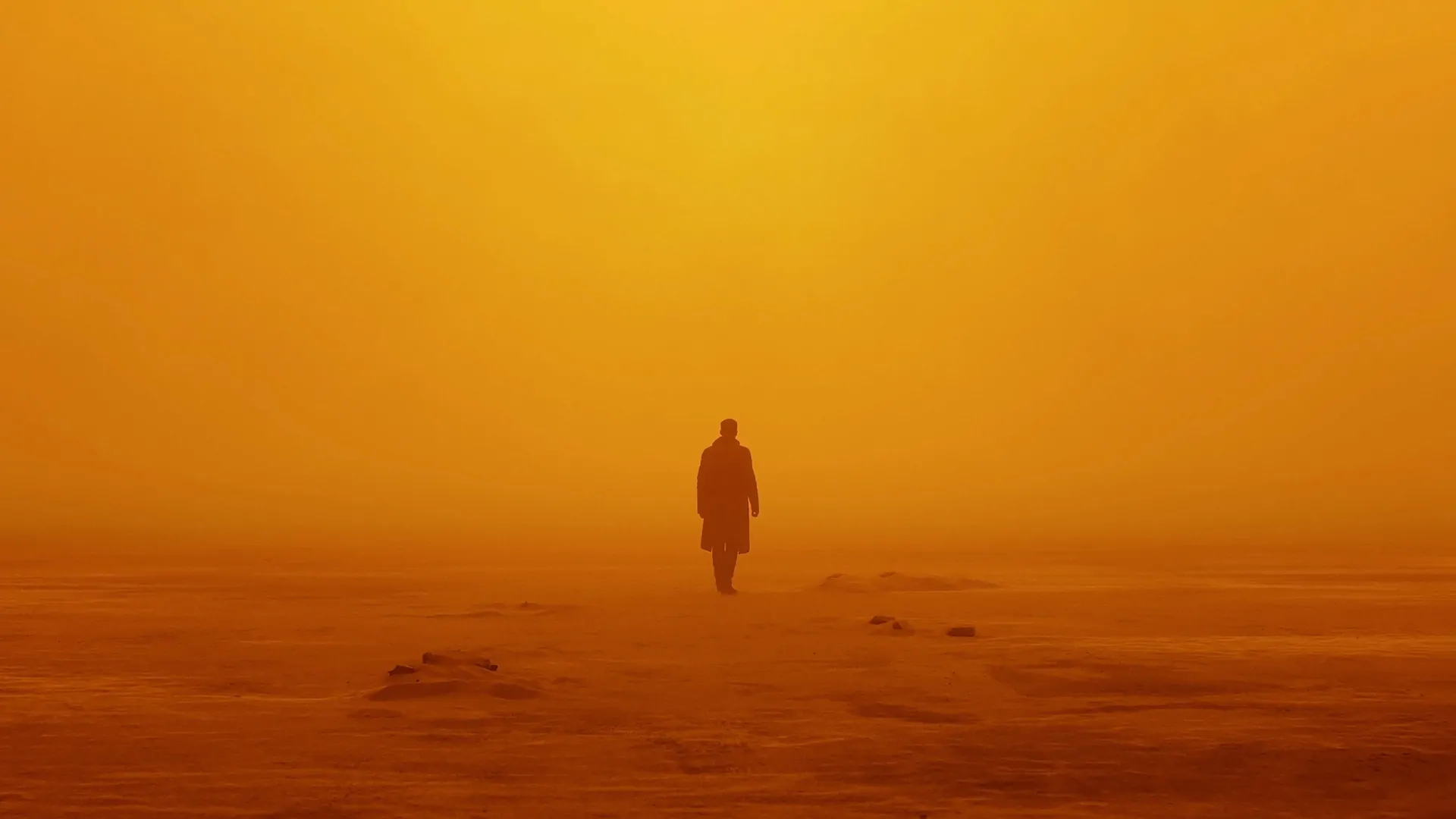Denis Villeneuve’s Blade Runner 2049 (2017) transports us to a dystopian earth, where humans and replicants, bio-engineered humans used for slave labour, live side by side. There is a clear dichotomy within the dystopia since replicants’ entire existence is based on the premise that they are genetically coded to obey orders, rendering them docile slaves, presented with an identity which they must conform to or be ‘retired’. Unfortunately for the protagonist K, the blade runner, this binary leaves him a murderer, retiring old replicants which have lost their utility. Nonetheless, what is significant about K, and many other replicants is the fact that they are conscious beings and can make decisions for themselves. A recurring theme in Blade runner and 2049 is whether replicants have humanity and thus 2049 uses the medium of a wooden horse to focus not on what differentiates them, but more interestingly, what fuses them together: consciousness. The horse therefore is used as a talisman for the replicants humanity and as a symbol of their resistance against human oppression.
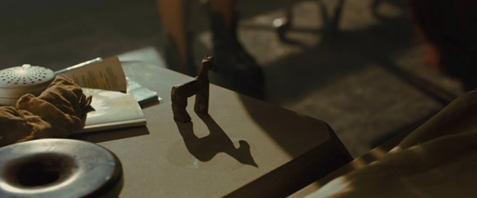
2049 narrates the birth of a hybrid, a child born to human father and replicant mother, a crime against humanity that could destabilise and rock the hierarchical foundations of the society which reduces replicants to be seen as slaves. Subsequently, one of K’s commands in 2049 is to find the hybrid and kill it, ensuring this revelation is not exposed. In his quest to find the hybrid, K begins to navigate memories about a wooden horse, the very horse which was made for the hybrid. Memories of replicants are imported, which reinforces the binary of human and replicant since to create memories first-hand, one must be sentient. As K relives such a vivid memory, he begins to believe that he is the hybrid, and thus the memory of the horse becomes to represent his humanity, the ability to be born and to think freely. Consequently, the wooden toy horse comes to visually represent the autonomy of replicants, and regardless of K being the hybrid or not, the memory of the horse fuels the fire of the replicant resistance.
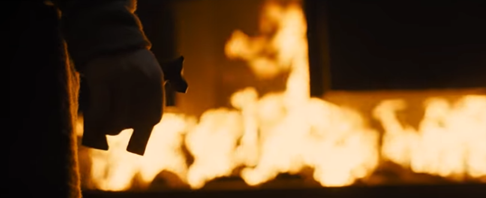
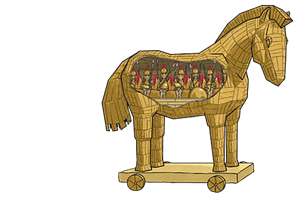
The equine nature of the toy is significant since it evokes stories of the Trojan Horse. The horse was initially perceived to be a sign of defeat, yet as the horse was rolled through the gates of Troy, thousands of soldiers hidden inside were released and attacked the city. The horse in 2049, albeit not filled with soldiers, offers the perspective that things aren’t necessarily what they seem to be on the surface. Consequently, the horse in 2049 is an inanimate object yet is given meaning, an animality that mirrors the playfulness and creativity of children, but the fire and passion of adults. Just like how the soldiers inside the Trojan horse gave their horse meaning, the replicants, albeit engineered to be docile, can choose to ascribe meaning to themselves, to choose to think, feel and act since they too are sentient, conscious beings. The animality of the horse therefore comes to represent the humanity of replicants.
The hybrid is a lieux de memorie, a site of historic consciousness and since the horse is owned by the hybrid, the horse becomes a physical challenge to the system. The horse, albeit an inanimate object, becomes a physical representation of humanity and resistance since the ‘hybridity of machine and organism ‘exposes, shifts and destroys boundaries’[1]. The very foundation of their society is challenged by replicants thinking for themselves and so the horse also represents the collective consciousness of replicants. The replicants standing in formation, clad in dark clothing represent the underdog, fighting the system which oppressed them, yet the light scattered in the background of the still below represents hope, a glimpse of a new life that the replicants have chosen and the horse serves as a tangible reminder, enabling the power of the memory to become real, something worth fighting for.
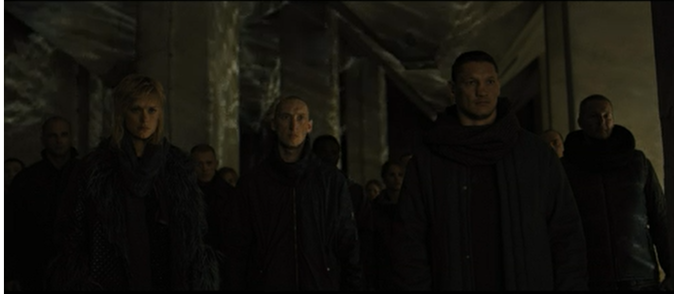
Consequently, K’s discovery of the horse in the furnace is ground-breaking. The mise-en-scene is significant since we see how connected K is to the natural world, despite being artificial. The ash on the horse soils his hands, highlighting the ridges of his fingerprints, conveying his own unique identity, something which we associate as exclusive to humans, yet here the fact that K has this, as a replicant, muddies the waters on whether he is replicant or human, animal or not, fake or real. Nonetheless, pulling the horse out of the furnace alludes to the myth of phoenixes, and how these animals are reborn out of the ashes of their predecessors, evoking the notion that replicants can procreate naturally. The tangible nature of the horse, and the sensory experience of touching a memory, conveys the possibility that K was born, not made, evoking a violent reaction in understanding how ground-breaking this psychological rebirth is. (insert clip 1 here – 3.23-3.43). The horse therefore reinforces the notion of replicants’ humanity
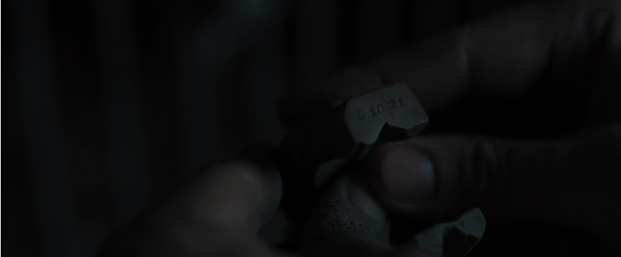
Similarly, the use of the close-up shot of the horse reminds us overtly of its significance, by taking centre stage. Moreover, the contemplative nature of this cinematic technique of slowly zooming in illustrates its semiotic significance in destroying boundaries by drawing parallels between humans and replicants. The tracking shot here, from the scene in the furnace to the scene of the horse is significant because the movement from over K’s shoulder to directly on his face, as seen in clip 1 to the horse in the centre of the screen conveys how the resistance movement is bigger than just K’s search for his personal humanity, it is about the humanity of all replicants. The merging of the two scenes weaves together how humans and replicants are not that dissimilar, and the animality of the horse, accentuated by the incoming light in the shot highlights the severity of the realisation of consciousness, of procreation and how replicants can overcome the very system which overpowers them.
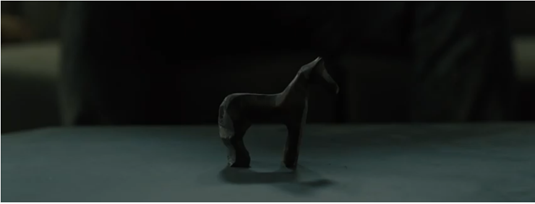
The horse, albeit man-made, is carved from a natural tree, representing future possibilities of growth, therefore whilst replicants are also man-made, the horse represents their ability to transcend what they were coded to do, and how they possess the consciousness to experience humanity. This is underpinned by Villeneuve’s use of extra-diegetic music. The long, high-pitched note layered on top of the deep, melancholic baseline (in clip 1) represents the hope of a different future, encouraging K to fight for what he believes is his. The layering of this long sonorific note conveys how K can overcome what he was made to do and become someone he wants to be. The wooden horse therefore becomes a bridge, like synapses fusing in a brain and uniting a conscious force, thus representing the humanity of replicants by signifying how those of artificial origin can become ‘more human than human’[2].
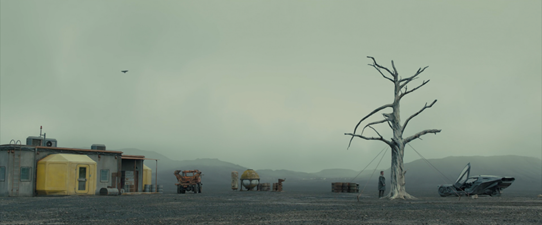
It is important to note that Villeneuve, using the horse to represent the humanity of replicants, is providing new insight onto the current discourse on binaries in our current society. For example, the gender binary, and the stereotypes that go with it, is deep rooted in an old system which we take for granted yet as society changes, so should our system that reflects them. In 2049, this binary provides replicants with one identity, one they must adhere to yet, albeit engineered, they are conscious, can procreate and can choose to be seen as human, their selected identity, and the state in 2049 should recognise, respect and welcome their personal choice. Consequently, Villeneuve draws parallels with our society and members of the trans community and how their reproductive rights are often hindered by legislation. By discouraging members of the trans community to become pregnant via law based on weak evidence, it delegitimises their chosen identity and thus strips them of their humanity.[3] The horse therefore comes to represent the collective conscious of the replicant force but may also represent trans people and their struggle for representation and rights in a society rooted in heteronormative binaries and cisnormativity. By challenging these binary frameworks which uphold this, we can choose to have a better life, where we are all seen by our chosen identity, as human beings, where ‘we are our own masters’[4].
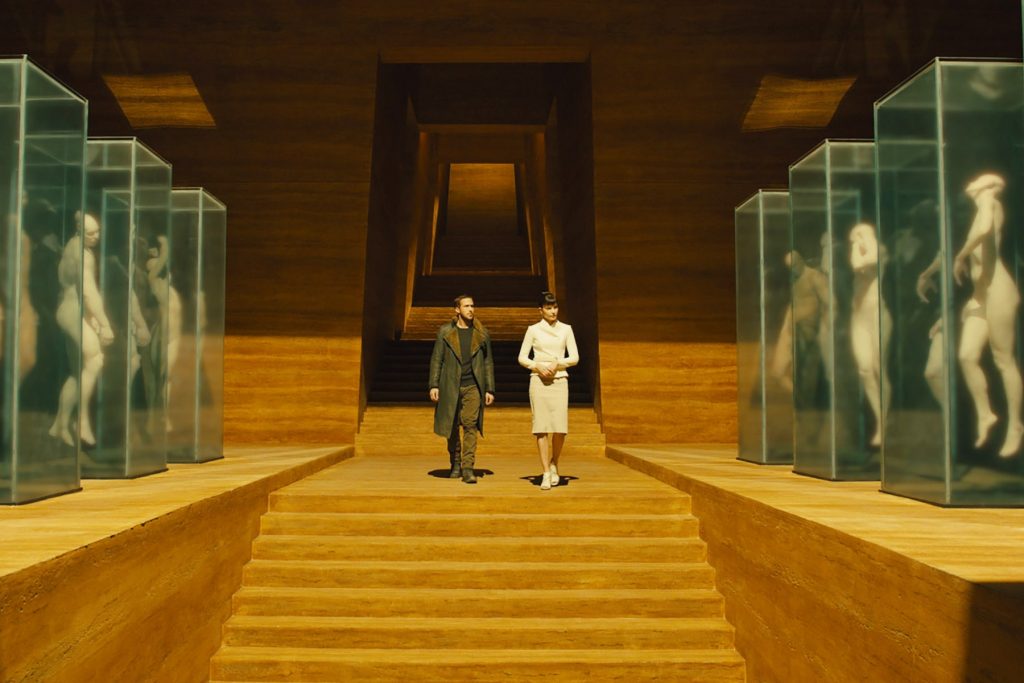
BIBLIOGRAPHY
Benjamin Schrader, ‘Cyborgian self-awareness: Trauma and Memory in Blade Runner and Westworld’, Theory&Event 22.4 (2019).
Blade Runner 2049, dir. By Denis Villeneuve (Alcon Media Group ,2017) in BBC iPlayer < https://www.bbc.co.uk/iplayer/episode/m0012ygz/blade-runner-2049>[accessed 20th December 2021]
Blas Radi, ‘Reproductive injustice, trans rights and eugenics’, Sexual and Reproductive Health Matters, 28.1 (2020).
Ali Riza Taskale, ‘Thanatopolitics and colonial logics in Blade Runner 2049’, Thesis Eleven 166.1 (2021).
Ali Riza Taskale, ‘Thoughts Interlinked: Corporate Imaginaries and Post-Capitalist Futures in Blade Runner 2049’ Critique 48.1 (2020).
Jane Stadler, ‘ Synthetic Beings and Synthespian Ethics: Embodiment Technologies in Science/Fiction’, Projections 13.2 (2019).
[1] Benjamin Schrader, ‘Cyborgian self-awareness: Trauma and Memory in Blade Runner and Westworld’, Theory&Event (2019) 22.4, (p.2).
[2] Blade Runner 2049, dir. By Denis Villeneuve (Alcon Media Group ,2017) in BBC iPlayer < https://www.bbc.co.uk/iplayer/episode/m0012ygz/blade-runner-2049>[accessed 20th December 2021]
[3] Blas Radi, ‘Reproductive injustice, trans rights and eugenics’, Sexual and Reproductive Health Matters, 28.1 (2020), 396-407, (pp.399-401).
[4] Blade Runner 2049, dir. By Denis Villeneuve (Alcon media Group ,2017) in BBC iPlayer < https://www.bbc.co.uk/iplayer/episode/m0012ygz/blade-runner-2049>[accessed 20th December 2021]
